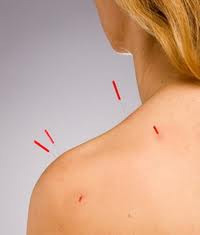Dry Needling

Paul also offers Dry Needling Therapy. Dry Needling, also known as Trigger Point Needling, is an effective and efficient technique for the treatment of myofascial pain and dysfunction.
Dry needling is especially effective in those areas which are muscle dense, e.g. gluteals and hips. Deep tissue treatment in these areas can sometimes be uncomfortable, tender and can bruise the tissue due to the pressure applied trying to reach the deeper layer of muscles. However, with the dry needling the therapist can go straight to the area that needs to be treated without causing bruising or exquisite tenderness.
A spasmed muscle becomes a damaged muscle. Spasm reduces blood flow in the muscle. This means less oxygen and food to the muscle. Putting a needle into a spasmed muscle causes the muscle to relax.
Specific exercises to stretch or strengthen certain muscles or muscle groups may be advised and taught
The benefits of Dry Needling frequently include more than just relief from a particular condition. Many people find that it can also lead to increased energy levels, better appetite and sleep as well as an enhanced sense of overall well being.
Frequently Asked Questions
- How does Dry Needling work?
- How does Dry Needling stop this cycle?
- Is dry-needling safe?
- What can Dry Needling help?
- Are there any reasons why I should not have dry-needling?
- Does dry-needling hurt?
- What should I do after Dry Needling?
- Does this affect my ability to donate blood?
- Where do you find Trigger Points and Myofascial Pain?
How does Dry Needling work?
Dry needling is an invasive procedure whereby solid filament (acupuncture) needles are inserted into the skin and muscle directly at a myofascial trigger point. A myofascial trigger point (sometimes known as a knot) consists of multiple contraction knots, which are related to the production and maintenance of the pain cycle.
The pioneering studies by Dr Shah and colleagues at the National Institutes of Health (USA) suggest that inserting a needle into trigger points can cause favorable biochemical changes which assist in reducing pain. It is essential to elicit a Local Twitch Response which is a spinal cord reflex and is the first step in breaking the pain cycle.
Something causes pain, if it happens often enough or if the trauma is great enough, the pain signal may return through the Sympathetic Ganglion and activate Primary Afferent Nocioceptors (H) which will feedback to the spinal cord. This will cause pain to continue instead of fade and is called a Reflex Arc. At the same time motor neurons may become stuck in a feedback loop/reflex arc facilitating muscle spasm. In some cases the reflex arc continues for years, even decades. Introducing a new stimulus (i.e. the needle) impedes the reflex arc and has the effect of relaxing the muscle.
How does Dry Needling stop this cycle?
A spasmed muscle becomes a damaged muscle. Spasm reduces blood flow in the muscle. This means less oxygen and nutrients to the muscle. Muscle fibers die off and get replaced by fibrous scar tissue. This in turn holds the muscle tight, prevents muscle metabolites from leaving the muscle and causes continued spasm and pain.
Is dry-needling safe?
Yes, studies have shown that it is one of the safest forms of medical intervention known. It is far safer than using drugs. Only sterile disposable needles are used.
What can Dry Needling help?
Dry needling can be used for a variety of musculoskeletal problems. Muscles are thought to be a primary contributing factor to the symptoms. Conditions which respond to dry needling include, but are not limited to:
- Muscle Spasms
- Headaches
- Frozen Shoulder
- Tennis elbow
- Carpal tunnel syndrome
- Golfer's elbow
- Fibromyalgia
- Sciatic Pain
- Buttock pain
- Leg pain
- Hamstring strains
- Shin splints
- Hip Pain
- Knee Pain
- Repetitive Strain Injuries
Are there any reasons why I should not have dry-needling?
There are very few. If you are taking anticoagulant medicines such as warfarin, or if you have skin infections near the trigger points, then needling should not be used. Obesity and pregnancy are also contraindications to dry needling.
Does dry-needling hurt?
The needle is so sharp and thin you will not feel it enter your skin. The amount of pain felt seems to vary from person to person, but almost everyone agrees the relief of pain from the treatment is well worth the "investment".
What should I do after Dry Needling?
Stretch the treated muscle as much as possible, 10 seconds by 3 at a time.
Does this affect my ability to donate blood?
No. The technique uses sterile disposable needles and does not come under the "acupuncture" category of the National Blood Transfusion Service. There is no need to declare you have had this form of treatment when donating blood.
Where do you find Trigger Points and Myofascial Pain?
Just about anywhere! In the muscles across the shoulders and in the neck they are a common cause of persistent headache. In the spine they cause back pain and in the buttock muscles cause hip and leg pain. Around the knee they cause pain referred to the knee and around the elbow they often cause pain similar to tennis elbow. They are a very common cause of shoulder pain.
For more information please contact Paul at:
Mob: +353 87 7507000 | Email: paul@paulmurray.ie
Our clinic is Covered by the following health insurers:





